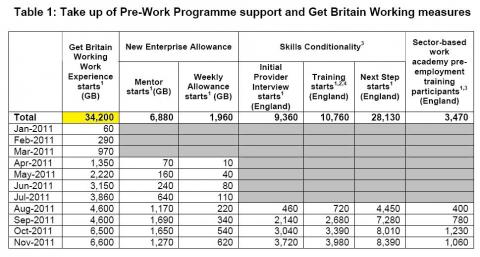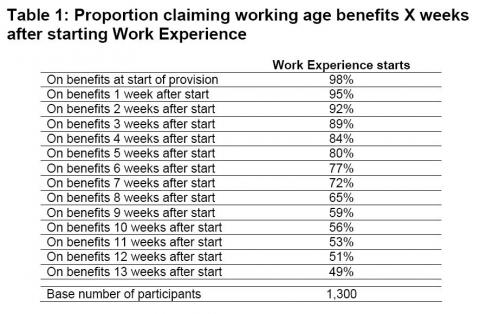Have 20,000 young people moved off benefits after Government-backed work experience placements?
"Nearly twenty thousand young people have already moved off benefits after doing work experience organised by Job Centre Plus."
Chris Grayling, Employment Minister, 19 February 2012
After a week of controversy surrounding work experience placements, Minister of State Chris Grayling hit back at critics of the Government's work experience programme in the Telegraph yesterday.
The Department for Work and Pensions (DWP) runs a 'Get Britain Working' programme through which it offers various types of placements to help young people gain experience in the jobs market.
One of Mr Grayling's defences of the project was that 20,000 young people had supposedly been taken off benefits after taking placements organised by Job Centre Plus.
So where did he get his figures from?
Analysis
The DWP record official statistics from the Get Britain Working programme from January 2011 onwards. The latest set provide figures of the number of participants in the various schemes set up by the Government, and are outlined in the table below:

The table demonstrates that there are a number of schemes available that have records. Taking the work experience starts alone shows that 34,200 starts to placements were made between January and November last year.
The demographic statistics from the same document show that 31,540 of these were young people aged between 18 and 24, with 2,610 over 25 and 50 unknown. While it is unclear what Mr Grayling meant when he referred to 'young people', the format of the data makes taking the 18-24 cohort a reasonable basis of assessment, especially as 24 is the upper age limit for calculating youth unemployment.
In judging how many of these participants were 'taken off benefits', the DWP also conducted an ad-hoc analysis in November last year in which it analysed the outcomes of those participating in the scheme.
The table below show the analysis applied to participants from the first three months of the scheme:

The base number of participants is roughly equivalent to the number of participants from January to March last year, in the first table. It indicates that, of the 1,300, 49 per cent or around 637 were still claiming working-age benefits a full 13 weeks after the placement started.
This means that approximately 663 individuals were taken off benefits from the January to March cohort of participants.
The DWP confirmed however that this was the most recent available ad-hoc analysis available, and thus the only available indicator at present of how many participants were taken off benefits after taking part in the scheme.
Nevertheless, to apply the same rates to the entire year, and hence to assume that 51 per cent of the participants would have been off benefits by 13 weeks after the placement began, of the 34,200 involved, around 17,442 would be estimated to have been taken off benefits. This could be interpreted as 'nearly 20,000'.
However, to further apply the more specific age ranges, out of 31,540 participants aged between 18 and 24 this figure would indicate that around 16,085 would no longer be on benefits after the 13 weeks - further shorter of the 20,000 figure.
However, the inadequacy of the available data should not be downplayed. The ad hoc analysis focuses on the scheme in its infancy when only 1,300 participants were measured. Despite the January to March period accounting for a quarter of the data's timeframe, it accounts for barely 4 per cent of the participants. A far more useful analysis would concern the vast numbers who took up the placements later in 2011.
Furthermore, it is not clear whether different age groups would have differing rates of benefit uptake after the 13 weeks and this level of detail was not clear in the available data. In addition, since the January to March period, several other schemes have taken effect and so the overall picture has changed considerably since the start of 2011.
Conclusion
Full Fact has contacted the DWP to confirm the source of Mr Grayling's claim. If his reasoning tallies with the calculations taken here, we can at best identify around 17,500 of his 'nearly 20,000 young people'. Being more age-specific in measure 'young people' could send the figure down to around 16,000.
However we should be cautious about drawing too many conclusions from this data, given that it extrapolates the findings of a relatively small-sample survey to what is now a much wider cohort. While the figures might be the best available to us, they are not necessarily strong enough to support the assertion made by the Employment Minister.
UPDATE (21/02/2012)
As we await a response from the DWP, one of our Twitter followers, @atm0spheric has pointed out an additional caveat to using the three-month period from January to March as a basis for extrapolating the findings. Since the rate at which young people enter the job market during a year is not constant, the figures need to be seasonally-adjusted if useful data is to be acquired from 2011 alone.